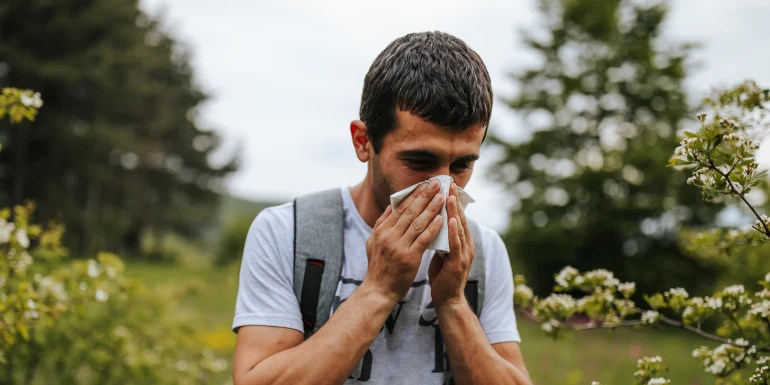
Allergies: symptoms and treatment
Lots of people suffer from allergies. But what allergies are there and what helps if you have an allergy? Find out what causes allergies and what the signs of an allergy are – and read about how you can treat allergies.
What is an allergy?
An allergy causes our immune system to develop a hypersensitive reaction to foreign substances that are actually harmless. The immune system produces antibodies against these allergy triggers, known as allergens. These are often plant or animal proteins, for example from pollen or food. When the antibodies make contact with the proteins, histamine is released. This messenger substance triggers the allergic symptoms.
Something that causes an allergic reaction in one person may be tolerated perfectly well by another. Each type of allergy comes with specific symptoms that can range from mild discomfort to severe reactions. Antonia Bordoni’s little boy has a severe egg allergy. Since he suffered his first allergic reaction at the age of 10 months, his mother has been looking for ways to protect her child in everyday life.
In the video, Antonia Bordoni explains how she came to set up a support group and why talking to other parents gives her reassurance and peace of mind.
But how do allergies actually develop? We still don’t fully understand why some people develop allergies and others don’t. Genetic factors, environmental influences and lifestyle can all contribute to developing an allergy. Researchers assume that allergies are triggered by a combination of multiple causes.
What allergies are there?
There are many different allergies. One of the most common is pollen allergy (hay fever), which mainly appears in spring and summer when trees, grasses and herbs are blooming. Animal allergies are also common, as is dust mite allergy. Food allergies and contact allergies (e.g. to fragrances) also affect a lot of people. Allergies to insect bites and medication are more rare but often very dangerous. Every one of these allergies has specific causes and symptoms that call for specific treatment approaches.
For pollen allergy – one of the most common allergies – there are tables that inform you about possible cross-allergies. A cross-allergy is caused when the immune system gets confused. People who react sensitively to airborne allergens can eventually develop a secondary food allergy. This is because certain protein structures, for example in pollen and food, are very similar.
Tip: if you suffer from a pollen or insect allergy, it’s worth taking a look at an allergy calendar. This tells you what allergies to look out for in specific months.
Allergies: what are the symptoms?
Symptoms of an allergy can vary depending on what type it is and how it manifests itself. However, there are some general signs you can look out for:
- Sneezing
- Reddened, watery eyes
- Tightness in your chest
- Wheezing
- Tingling in your mouth
- Swelling of your tongue or lips
- Reddened skin
- Hives (nettle rash)
- Itching
- Nausea
- Stomach ache
- In serious cases: asthma, circulatory shock
Allergies and intolerances affect our well-being, but there are differences between them. An allergy exists when the immune system reacts to a substance that most people find harmless. When the immune system comes into contact with the allergen, it overreacts.
Intolerances, on the other hand, are not immune reactions. They occur when the body has difficulties digesting certain foods or their components properly. This may be caused by a deficiency in a certain enzyme. A classic example is lactose intolerance, where the body is unable to break down the milk sugar lactose properly because it lacks the enzyme lactase.
What types of allergy are there?
Allergies are very complex and manifest themselves in different forms. These forms depend on how and when the immune system reacts. But which four specific allergy types are there?
Type I allergy: immediate reaction
Type I allergies are the most common and affect people who have IgE antibodies against the relevant allergens. These antibodies normally protect us from parasites. With a type I allergy, the immune system reacts within a few minutes of contact with the allergens. These can be pollen, animal hair and food, but also bee or wasp venom.
Type II allergy: cytotoxic allergy
This is where allergens bind to the body’s own cells, which are attacked by the immune system. The reaction can occur in minutes or hours. Triggers include blood transfusions or medication (e.g. painkillers or antibiotics).
Type III allergy: immune complex reaction
This type involves IgG, IgA and IgM antibody and allergen complexes forming in the blood after several hours. These complexes can result in inflammation of the blood vessels if the immune system is not able to eliminate them. Type III allergies are relatively rare. They are triggered by medicines and certain venoms such as those produced by snakes.
Type IV allergy: cell-mediated delayed-type allergy
With this type of allergy, the reaction comes up to twelve hours to three days after contact with the allergen. Immune cells (T cells) stimulate the immune system. A contact allergy is a typical example. This involves a skin rash that occurs when part of the body comes into contact with a specific allergen (e.g. nickel).
Anaphylactic shock is an acute, life-threatening allergic reaction that requires immediate medical attention. This reaction is also known as anaphylaxis. Possible symptoms of anaphylactic shock include difficulty breathing, drop in blood pressure, dizziness or unconsciousness, skin rash, digestive problems, nausea and diarrhoea. Usually several organs react simultaneously, such as the lungs, circulatory system and skin.
If you are prone to anaphylaxis, you should always carry an allergy emergency kit with you. This emergency kit must contain allergy tablets, an adrenaline auto-injector and other medication prescribed by your doctor for this purpose.
Allergy test: how can a diagnosis be made?
Doctors use special tests to diagnose allergies. The skin prick test, a reliable way to test for allergies, is among the most common methods. In this allergy test, the specialist applies small amounts of various allergens to your skin and gently pricks it. If the skin reacts with redness or swelling, you are allergic to the allergen in question.
Other ways of diagnosing an allergy under medical supervision are:
- Blood test: blood is tested for certain IgE antibodies produced by the body during an allergic reaction. A higher value indicates an allergy.
- Provocation test: the suspected allergen is applied to the nasal mucous membrane, inhaled or ingested. The reactions to this are recorded. This test is suitable for diagnosing respiratory, medication and food allergies.
- Plaster test: the test allergens are applied to the patient’s back using a plaster and observed for one to two days. The patch test (epicutaneous test) identifies contact allergies.
- Hydrogen breath test: determines intestinal disorders, such as lactose or fructose intolerance.
Allergies: how are they treated?
Several methods are used to treat allergies. The most important method is to eliminate the allergens. An anti-allergy drug, also known as an antihistamine, can also reduce allergy symptoms such as sneezing and itching. This medication blocks the effect of histamine, a substance released by the body during an allergic reaction. Antihistamines are available in various forms, such as allergy tablets, nasal sprays or eye drops. As well as antihistamines, there are also nasal sprays containing corticosteroids, which help with hay fever, as well as special creams. These are mainly used if the allergy causes a rash.
In addition, desensitisation is also possible in some cases. This involves the attending physician deliberately exposing the person affected to an allergen and gradually increasing the dose. When the highest dose tolerated by the patient is reached, the patient is exposed to it on a monthly basis. The aim is to reduce or, ideally, completely eliminate the symptoms.
Think that you might be allergic to something? If so, talk to your doctor about it. Based on the diagnosis, they will draw up a treatment plan to give you day-to-day support.
Treating allergies – can complementary medicine also be helpful?
Alternative methods can be an important addition to the range of allergy treatments that are available. Acupuncture, for example, has been scientifically proven to help treat allergies and asthma. And because allergic reactions can be exacerbated by stress, relaxation techniques such as MBSR and yoga can help improve your well-being. COMPLETA supports you with a variety of contributions.

This specialist provided the editorial team with expert advice and input for this article. Peter Schmid-Grendelmeier is head of the allergy department of the Dermatology Clinic at the University Hospital in Zurich. He specialises in allergies of all kinds, including neurodermatitis and urticaria (hives, nettle rash), tropical and travel dermatology and histamine-mediated diseases.


Newsletter
Find out more about current health issues every month and get all the information you need about our attractive offers from all Helsana Group companies * delivered by e-mail to read whenever it suits you. Our newsletter is free of charge and you can sign up here:
We did not receive your information. Please try again later.
* The Helsana Group comprises Helsana Insurance Company Ltd, Helsana Supplementary Insurances Ltd and Helsana Accidents Ltd.